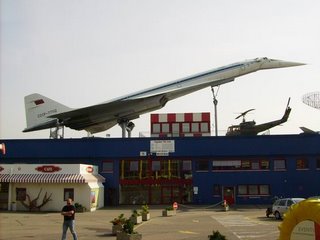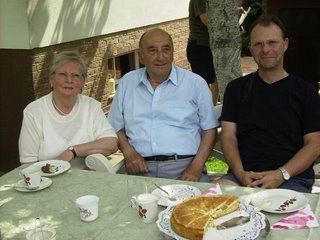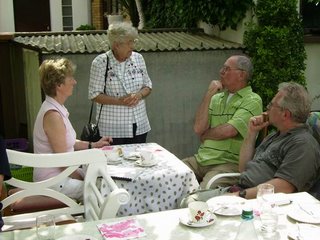Thursday, June 15 - Mainz
The plan for today was to take a side road to visit two smaller, picturesque villages en route to Heidelberg. However, before we left Canada, Helmut Kaiser warned that these side roads can become extremely crowded on holidays, which today is, and estimating time is very unreliable. So we decided to go direct to Heidelberg and spend more time there.
 After a few kilometres, Helmut remarked that we would soon pass a technical museum along the way. This was of mild interest to the guys, but we weren’t keen to amend our plan – until we drove by and saw a Concorde and the Russians’ Concorde copy along with a dozen
After a few kilometres, Helmut remarked that we would soon pass a technical museum along the way. This was of mild interest to the guys, but we weren’t keen to amend our plan – until we drove by and saw a Concorde and the Russians’ Concorde copy along with a dozen  other planes mounted on pedestals beside the highway. Within seconds, the girls were outvoted 5 to 6 by the guys. They weren’t too thrilled, but
other planes mounted on pedestals beside the highway. Within seconds, the girls were outvoted 5 to 6 by the guys. They weren’t too thrilled, but  we argued that we had made many detours for one person in the last three weeks, so a detour for 5 people was easily defensible, especially when one of them was the driver. They grudgingly accepted our argument, although they weren't too happy about it, and we were on our way to the museum.
we argued that we had made many detours for one person in the last three weeks, so a detour for 5 people was easily defensible, especially when one of them was the driver. They grudgingly accepted our argument, although they weren't too happy about it, and we were on our way to the museum.
 We spent a little more than an hour and were only able to do a quick walk through. There were easily 100 cars, ranging from the 1930s to recent times and including many race cars. There were dozens of motorcycles and airplanes, about a dozen railway locomotives, several dozen World War II vehicles from most of the involved
We spent a little more than an hour and were only able to do a quick walk through. There were easily 100 cars, ranging from the 1930s to recent times and including many race cars. There were dozens of motorcycles and airplanes, about a dozen railway locomotives, several dozen World War II vehicles from most of the involved  nations, farm machinery, construction machinery, and too much else to mention it all. Trevor even said that he found a section on sewing machines. Not only was there a lot there, but the presentation was very high quality. We could easily have spent a full day or more, but we had a promise to keep, so, with tears in our eyes, we moved on. I would highly recommend this museum if you are ever in this area, especially if you are a guy.
nations, farm machinery, construction machinery, and too much else to mention it all. Trevor even said that he found a section on sewing machines. Not only was there a lot there, but the presentation was very high quality. We could easily have spent a full day or more, but we had a promise to keep, so, with tears in our eyes, we moved on. I would highly recommend this museum if you are ever in this area, especially if you are a guy.
 In Heidelberg, we first went to Schloss Heidelberg where we finished up our leftovers from yesterday and toured the grounds. There is a terrific view of the city below from there. We then went down to the Old Town and toured around for another hour.
In Heidelberg, we first went to Schloss Heidelberg where we finished up our leftovers from yesterday and toured the grounds. There is a terrific view of the city below from there. We then went down to the Old Town and toured around for another hour.
At 2:15 we departed for a much anticipated appointment. Before departure from Canada, I had discussed with Helmut Kaiser the possibility of meeting with him and Peter Noll. For anyone who doesn’t know, Peter Noll is the man who sorted all the microfilmed Zichydorf church records into family groups. Helmut Kaiser made Herr Noll’s work available on the web and later expanded it after we had obtained the more recent records. Herr Kaiser and I had concluded that the best plan was for him to come to Herr Noll’s house where we would join them for coffee and cake at 3 p.m.
We arrived a few minutes early and were promptly ushered in to a very pleasant patio and yard where a table had been set for our arrival. Because we were early, other people arrived after us, including Herr Schleicher (another Zichydorfer) and his wife and Herr Noll’s sons, Gerhard and Helmut, along with their spouses. Next thing you know there were five cakes on the table. Sadly, I could only manage to sample three, despite encouragement from Frau Noll. Soon wine was also on the table. By 4:30, a trip to the Biergarten seemed like a good idea, so we all went to one nearby until our planned departure at 5:30. We all enjoyed our visit very much and it seemed that they did too. It is surprising how much gemutlichkeit can be generated in such a short time by virtual strangers.
Here are Olga and Perter Noll and their eldest son, Gerhard.

 This picture shows Hannelore Kaiser, Betty Harle, Helmut Kaiser, and Daryle Niedermayer.
This picture shows Hannelore Kaiser, Betty Harle, Helmut Kaiser, and Daryle Niedermayer.
 Here are Bev Fritz, Hannelore Kaiser, Olga Kaiser, Baz Fritz, and Helmut Noll, the younger Noll son.
Here are Bev Fritz, Hannelore Kaiser, Olga Kaiser, Baz Fritz, and Helmut Noll, the younger Noll son.
 And here is the whole gang, including Herr Schleicher and his wife.
And here is the whole gang, including Herr Schleicher and his wife.
There were some more sombre moments to the afternoon as the two gentlemen recalled some of their post-war experiences. Herr Kaiser spent four years in Rudolfsgnad internment camp from age 7, watching people die all around him. He recalls that, at age 9, there was no water in the camp, so he took a cup down to the forbidden river and was shot at by the guards. His father had been an officer in the Yugoslavian Army and was taken into the German Army when Hitler invaded. His Serbian former fellow officers ensured that he was executed almost immediately after surrender. Herr Noll was a 17 year old soldier when the war ended. He was taken to forced labour in a Russian mine for seven years, robbing him of what many would consider to be the best years of their lives. Imagine the 17-24 year olds that you know in this situation. It was very easy for all of us gathered in the Plandiste mayor's office to say "Let's put the past behind us and work together in the future," but no one in that room experienced the times that these men did. For them, forgetting is not easy.
After much hand-shaking and many thank yous all around, we got under way about 5:45. Rain was threatening as we left and soon we were driving through a thunder shower. It only lasted a short while ans soon we were under brighter skies again. We got into our hotel by about 7 and discovered that our hotel has quite reasonably priced WLAN. I know what my evening will look like. Some of the others went out to eat, but I am so full of cake and beer, that I haven’t felt like going out yet.
 After a few kilometres, Helmut remarked that we would soon pass a technical museum along the way. This was of mild interest to the guys, but we weren’t keen to amend our plan – until we drove by and saw a Concorde and the Russians’ Concorde copy along with a dozen
After a few kilometres, Helmut remarked that we would soon pass a technical museum along the way. This was of mild interest to the guys, but we weren’t keen to amend our plan – until we drove by and saw a Concorde and the Russians’ Concorde copy along with a dozen  other planes mounted on pedestals beside the highway. Within seconds, the girls were outvoted 5 to 6 by the guys. They weren’t too thrilled, but
other planes mounted on pedestals beside the highway. Within seconds, the girls were outvoted 5 to 6 by the guys. They weren’t too thrilled, but  we argued that we had made many detours for one person in the last three weeks, so a detour for 5 people was easily defensible, especially when one of them was the driver. They grudgingly accepted our argument, although they weren't too happy about it, and we were on our way to the museum.
we argued that we had made many detours for one person in the last three weeks, so a detour for 5 people was easily defensible, especially when one of them was the driver. They grudgingly accepted our argument, although they weren't too happy about it, and we were on our way to the museum. We spent a little more than an hour and were only able to do a quick walk through. There were easily 100 cars, ranging from the 1930s to recent times and including many race cars. There were dozens of motorcycles and airplanes, about a dozen railway locomotives, several dozen World War II vehicles from most of the involved
We spent a little more than an hour and were only able to do a quick walk through. There were easily 100 cars, ranging from the 1930s to recent times and including many race cars. There were dozens of motorcycles and airplanes, about a dozen railway locomotives, several dozen World War II vehicles from most of the involved  nations, farm machinery, construction machinery, and too much else to mention it all. Trevor even said that he found a section on sewing machines. Not only was there a lot there, but the presentation was very high quality. We could easily have spent a full day or more, but we had a promise to keep, so, with tears in our eyes, we moved on. I would highly recommend this museum if you are ever in this area, especially if you are a guy.
nations, farm machinery, construction machinery, and too much else to mention it all. Trevor even said that he found a section on sewing machines. Not only was there a lot there, but the presentation was very high quality. We could easily have spent a full day or more, but we had a promise to keep, so, with tears in our eyes, we moved on. I would highly recommend this museum if you are ever in this area, especially if you are a guy. In Heidelberg, we first went to Schloss Heidelberg where we finished up our leftovers from yesterday and toured the grounds. There is a terrific view of the city below from there. We then went down to the Old Town and toured around for another hour.
In Heidelberg, we first went to Schloss Heidelberg where we finished up our leftovers from yesterday and toured the grounds. There is a terrific view of the city below from there. We then went down to the Old Town and toured around for another hour.At 2:15 we departed for a much anticipated appointment. Before departure from Canada, I had discussed with Helmut Kaiser the possibility of meeting with him and Peter Noll. For anyone who doesn’t know, Peter Noll is the man who sorted all the microfilmed Zichydorf church records into family groups. Helmut Kaiser made Herr Noll’s work available on the web and later expanded it after we had obtained the more recent records. Herr Kaiser and I had concluded that the best plan was for him to come to Herr Noll’s house where we would join them for coffee and cake at 3 p.m.
We arrived a few minutes early and were promptly ushered in to a very pleasant patio and yard where a table had been set for our arrival. Because we were early, other people arrived after us, including Herr Schleicher (another Zichydorfer) and his wife and Herr Noll’s sons, Gerhard and Helmut, along with their spouses. Next thing you know there were five cakes on the table. Sadly, I could only manage to sample three, despite encouragement from Frau Noll. Soon wine was also on the table. By 4:30, a trip to the Biergarten seemed like a good idea, so we all went to one nearby until our planned departure at 5:30. We all enjoyed our visit very much and it seemed that they did too. It is surprising how much gemutlichkeit can be generated in such a short time by virtual strangers.
Here are Olga and Perter Noll and their eldest son, Gerhard.

 This picture shows Hannelore Kaiser, Betty Harle, Helmut Kaiser, and Daryle Niedermayer.
This picture shows Hannelore Kaiser, Betty Harle, Helmut Kaiser, and Daryle Niedermayer. Here are Bev Fritz, Hannelore Kaiser, Olga Kaiser, Baz Fritz, and Helmut Noll, the younger Noll son.
Here are Bev Fritz, Hannelore Kaiser, Olga Kaiser, Baz Fritz, and Helmut Noll, the younger Noll son. And here is the whole gang, including Herr Schleicher and his wife.
And here is the whole gang, including Herr Schleicher and his wife.There were some more sombre moments to the afternoon as the two gentlemen recalled some of their post-war experiences. Herr Kaiser spent four years in Rudolfsgnad internment camp from age 7, watching people die all around him. He recalls that, at age 9, there was no water in the camp, so he took a cup down to the forbidden river and was shot at by the guards. His father had been an officer in the Yugoslavian Army and was taken into the German Army when Hitler invaded. His Serbian former fellow officers ensured that he was executed almost immediately after surrender. Herr Noll was a 17 year old soldier when the war ended. He was taken to forced labour in a Russian mine for seven years, robbing him of what many would consider to be the best years of their lives. Imagine the 17-24 year olds that you know in this situation. It was very easy for all of us gathered in the Plandiste mayor's office to say "Let's put the past behind us and work together in the future," but no one in that room experienced the times that these men did. For them, forgetting is not easy.
After much hand-shaking and many thank yous all around, we got under way about 5:45. Rain was threatening as we left and soon we were driving through a thunder shower. It only lasted a short while ans soon we were under brighter skies again. We got into our hotel by about 7 and discovered that our hotel has quite reasonably priced WLAN. I know what my evening will look like. Some of the others went out to eat, but I am so full of cake and beer, that I haven’t felt like going out yet.

0 Comments:
Post a Comment
<< Home